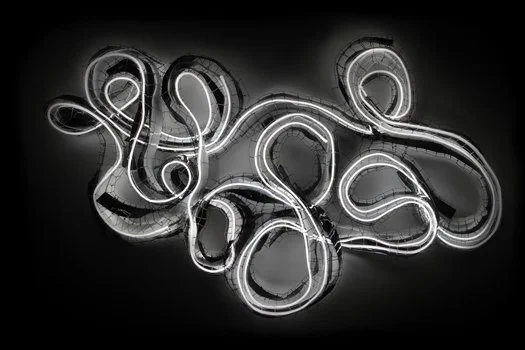Hannah Quinlivan
Nocturne
ESSAY | Flinders lane gallery | December 2020
Harnessing the vast generative potential of line, Hannah Quinlivan translates contemporary experience into abstracted sequences that poke at the parameters of drawing. Formal qualities of light, shadow, shape and texture conjure subtle symbolic currencies that synthesise intimate moments from the artist’s own life with broad collective affairs.
Developed throughout the tumultuous year of 2020, Quinlivan’s new series of ‘spatial drawings’ brings together wire and LED installations tracing the vicissitudes – personal and shared – of ecological and economic crises. While many of the artist’s earlier pieces were ephemeral – enlisting decomposable materials such as salt and tape, as well as performative elements – the works in ‘Nocturne’ signal a new emphasis on permanence. Crafted from hand-cut acrylic sheets, heated and moulded with aluminium wire, they emblematically fix our fears firmly in place at a time when climate change is no longer a distant threat; it is here and now, vehement and permanent.
Observing the fissures in collective consciousness wrought by recent disasters, Quinlivan has been trying to gather and translate, in visual form, the structure of a feeling pertinent to a particular time and place. Here she engages with Ben Anderson’s phenomenological concept of ‘the affective atmosphere’, looking at the tensions settling on life after periods of crisis. Anderson suggests that atmospheres are not solely located in material environments nor in the human body, but they emerge from the resonances between these components; they are ‘always in the process of emerging and transforming’. Quinlivan responds to this idea by constructing undulating organic forms that twist and turn in amorphous loops, evading fixed modes of being. Transmissions of fear and anxiety in an era of instability manifest in the piercing spatio-materiality of wire and acrylic, yet these materials are configured by Quinlivan with such tenderness and empathy that they are not without promise, and hope. ‘There is the realisation that we take so much for granted’, reflects Quinlivan, ‘We are needing to re-examine how we live and support each other … to find the fortitude to care for each other through the uncertain future’.
Germinating during the height of the Summer wildfires, the works in ‘Nocturne’ respond to the slow unravelling of our ecology. In Shroud, rippling coils of smoke curl around each other like some sort of twisted ouroboros. There is no beginning and no end here, only a ceaseless cycle. Embalmed in the work is the artist’s own experience of the dense plumes that shrouded and penetrated her home in Canberra for two months, forcing her to tape up the windows and protect her family. In a similar sense, the woven black forms of the title piece Nocturne resemble the exoskeleton of a space that has been internally burnt, pillaged. Silhouetted vertical forms dangle from the ceiling like spectral presences, or absences, conflating the formlessness of smoke with the solidity of charcoal. This work charts a changed and changing ontology – the affective atmosphere – in which known modes of feeling and being have evanesced into distant clouds. We have entered a new time wherein presence rubs up against absence in a warm anthropogenic friction, destabilising the future that once was.
Choreographing light and line into a cathartic tangle, Desiderium asks its audience to pause. To take time. To look. Tracing our eyes along the serpentine LED strand is an exercise in absolving the futures we once possessed – of realising that the path before us is not straight but profoundly contorted. And, yet, there is still light to cling onto; a muted hope. We are not yet in darkness.
